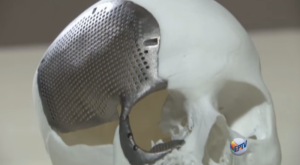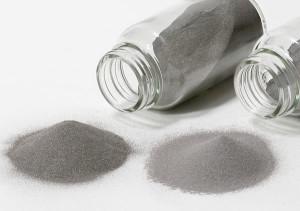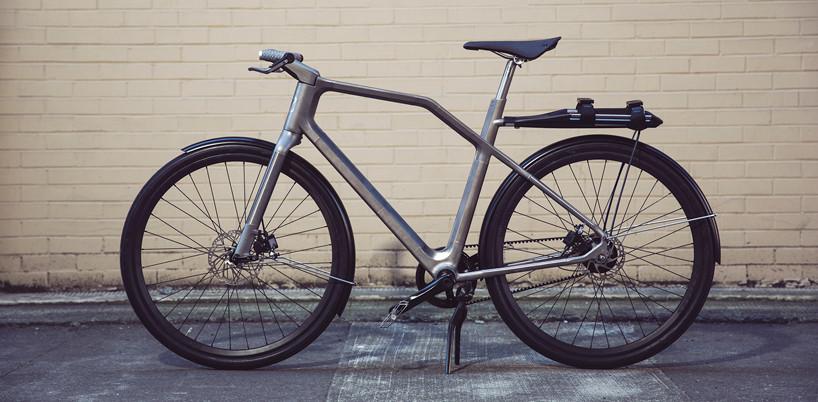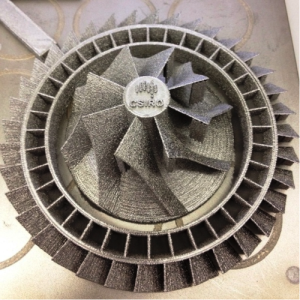 3D printing with metals has been around for a few years now, but as the technology and software that run 3D printers drop in price, it is starting to be adopted by a rapidly increasing number of industries. One of the most desired industrial quality metals is titanium, a low density, high strength metal that is highly resistant to corrosion and has a very high melting point. This makes the material ideally suited for a number of industries, including aerospace, automotive, military applications, medical prostheses, orthopedic implants, dental implants and even jewelry. And now that titanium can be 3D printed it is in more demand than ever before. The Titanium Processing Center is a Michigan-based titanium distributor that sells the material in a wide variety of forms, including bars, rods, tubes, plate and of course 3D printing powders.
3D printing with metals has been around for a few years now, but as the technology and software that run 3D printers drop in price, it is starting to be adopted by a rapidly increasing number of industries. One of the most desired industrial quality metals is titanium, a low density, high strength metal that is highly resistant to corrosion and has a very high melting point. This makes the material ideally suited for a number of industries, including aerospace, automotive, military applications, medical prostheses, orthopedic implants, dental implants and even jewelry. And now that titanium can be 3D printed it is in more demand than ever before. The Titanium Processing Center is a Michigan-based titanium distributor that sells the material in a wide variety of forms, including bars, rods, tubes, plate and of course 3D printing powders.
In order to keep their customers informed, and to help educate the public about what metals can be 3D printed, the Titanium Processing Center produced a helpful infographic called 3D Printing with Titanium. The infographic does a great job laying out what can be produced, when it should be used and why it is in such high demand. But there is only so much information that can be included in an infographic without overwhelming the reader or simply turning it into a comic book. Since there is still more to learn about 3D printing with titanium, it will help us to take a closer look at the material and its capabilities.
Titanium is the strongest material that can currently be used in 3D printing, not to mention that it is the lightest metal as well. Traditionally, when products are manufactured from titanium they need to be tooled with a CNC mill, or poured into a mold. But because 3D printing allows for virtually unlimited complexity it is actually quite cost effective to use additive manufacturing to produce products. 3D printed titanium is primarily used in the aerospace, dental and medical fields, specifically for medical implants due to its non-toxicity, high strength and resistance to corrosion. Current metal 3D printing technology allows titanium parts to be printed down to 0.25 mm layers with a minimum wall thickness as small as 0.4 mm.
3D printed titanium is typically made on a powder bed metal 3D printer that uses a process called direct metal laser sintering (DMLS). An arm spreads a thin layer of extremely fine titanium powder down into the printing bed while a powerful carbon dioxide laser is used to melt the powder and fuse the titanium together. The process is similar to a 2D printer that moves the printing head over the paper and deposits the ink, only with a DMLS printer the laser replaces the inkjet. This metal 3D printing process can typically melt together titanium in layers of about 20 to 40 µm.
The resulting 3D printed parts will not have the typical shiny, chrome-like finish that is often associated with titanium. Because the printer is producing a completely unpolished piece of raw metal, instead the parts will have a dull gray finish. Any parts can be polished manually to produce the desired finish that looks almost identical to any traditionally manufactured parts. There will also be a noticeable striation on any raw, 3D printed parts where each layer was melted together. However, modern 3D printing software can often optimize the angle that parts are printed at both to avoid striation, and to produce stronger parts.
Not everything can be 3D printed in titanium, however — at least not yet. Because it cannot be joined together the way that steel can there are size limitations to what titanium objects are suitable to be 3D printed. Something like the individual parts for a bicycle frame, a knee replacement, a cell phone case or a valve for an engine are all easily fabricated — although large components that need to be made as a single part wouldn’t be a good idea. Nor would any objects that have multiple angular shapes or edges due to the powder bed process being unable to prevent some striation to remain after the sintering process.
For many applications 3D printing titanium has some very clear and obvious benefits. Because titanium is one of the strongest metals available, 3D printing it into shapes that are impossible with traditional manufacturing and fabrication methods offers industrial designers a whole new set of design limitations that are considerably less restrictive, and the ability to create prototypes quickly and at a much lower cost. This means that they can produce superior products that have gone through several more design cycles to work out any potential design bugs. 3D printing can also produce end-use products or a small run of identical objects. It also allows manufacturers to offer titanium products that can be customized at no additional production cost.
You can find out more about the benefits of 3D printing titanium parts and products over on the Titanium Processing Center website. Let’s hear your thoughts on this guide in the 3D Printing With Titanium forum thread on 3DPB.com.
Subscribe to Our Email Newsletter
Stay up-to-date on all the latest news from the 3D printing industry and receive information and offers from third party vendors.
You May Also Like
3D Printing Unpeeled: New Arkema Material for HP, Saddle and Macro MEMS
A new Arkema material for MJF is said to reduce costs per part by up to 25% and have an 85% reusability ratio. HP 3D HR PA 12 S has been...
3D Printing News Briefs, January 20, 2024: FDM, LPBF, Underwater 3D Printer, Racing, & More
We’re starting off with a process certification in today’s 3D Printing News Briefs, and then moving on to research about solute trapping, laser powder bed fusion, and then moving on...
3D Printing Webinar and Event Roundup: December 3, 2023
We’ve got plenty of events and webinars coming up for you this week! Quickparts is having a Manufacturing Roadshow, America Makes is holding a Member Town Hall, Stratafest makes two...
Formnext 2023 Day Three: Slam Dunk
I’m high—high on trade show. I’ve met numerous new faces and reconnected with old friends, creating an absolutely wonderful atmosphere. The excitement is palpable over several emerging developments. The high...



































